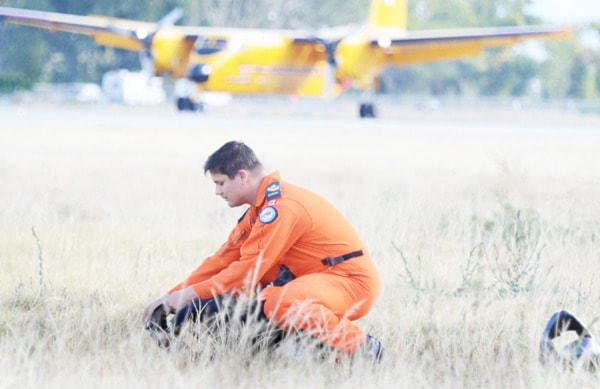Expect the unexpected.
In his eight years as a military search and rescue technician (SAR tech), Sgt. Kaulin Damron has found that to be the only constant in the job.
“Personally, I don’t go through any real type of preparation like anticipating someone being deceased or anything like that because you just never know what you are going to find,” said the 38-year-old while on a recent training exercise in the South Okanagan with the Comox-based 442 Squadron. “I look at it as going in and if they are (deceased), they are, and if they’re not, they’re not. We have the ability to deal with the people whether they’re walking wounded, injury-free to deceased or missing.
“There’s always going to be red herrings, little hiccups you have to deal with and that’s the beauty of the job, every day and every mission is different, there’s nothing repetitive.”
The SAR tech finds when he heads out on a mission, whether parachuting into the mountains, doing a long-line rescue from the helicopter or jumping into the ocean fully geared, he simply reverts to the comprehensive skills he has learned over the years.
While stressing his role and that of the other techs as first responders is, “at the pointy end,” there is an entire machine of support behind them in terms of help in emergency situations.
Damron also credits the training for keeping his nerves in check when going into often volatile situations.
The SAR tech does admit now and then when an event is over, he does have an anxious moment or two.
“I guess sometimes after a mission or after a jump you sit back and go, ‘Ooohhh, that was a little non standard or that was a little hairy,’” he said. “Then you look back in hindsight and ask yourself if you would have done the same thing, and generally I always turn around and say: ‘Yeah I would have done the same thing.’
“Generally you don’t get into trouble in good weather, usually people are trying to get out of it and we’re trying to get in.”
Damron actually joined the infantry in 1991, but after few years decided he was looking for a “higher calling” and more challenge, so search and rescue was his choice.
He wasn’t disappointed.
The SAR tech vividly recalls the first mission just a couple of months into his term.
“It was my first jump operationally,” said Damron.
“We jumped into a tiny island in the Arctic Circle about 25 miles out to sea. That was my first experience with deceased persons and an overturned boat and missing persons. I think that was a huge eye opener and great entrance into the trade.”
Unlike other aspects of the military, while just as important, Damron enjoys seeing the results of his labour in real time.
Not surprisingly, his favourite part of the job is helping people in trouble, and to him there is no greater reward than saving someone’s life, even if it means risking his own.
